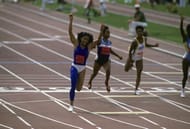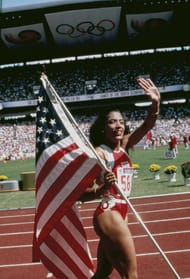You are an Olympic silver medallist working as a bank secretary when your coach nonchalantly proclaims to the media about you being 60 pounds overweight. Two years later, you run just your fourth serious 100m race and set a record of 10.49s that remains unbroken for a quarter of a century.
A year later you retire almost inexplicably to set tongues wagging about the timing of it all. And yes, of course, you run fast and look good too while you are at it. You are Florence Delorez Griffith Joyner.
Much like the above paragraph, Joyner’s life came to be dissected into the bizarre and the beautiful. She didn’t come across as your run-of-the-mill gorgeous or manicured beauty but was more of a sinewy fashionista. Confidence was her religion and profession. She broke records for a living and made heads turn as a habit.
Born in Los Angeles in 1959 as the seventh child in a family of 11, Joyner was brought up on a healthy diet of self-reliance and purposeful parenting. Her mother, a seamstress, encouraged her to pursue anything and everything she fancied.
Truth be told, she did them all. She authored a litany of children’s books featuring a character named Barry Bam Bam, was a poet, fashion designer, actress and model. In 1989 she even helped design new uniforms for the Indiana Pacers, a highly respected basketball team.
Flo-Jo, as she was fondly nicknamed, finished 6th at the CIF California State meet in 1978 behind future teammates Alice Brown and Pam Marshall. She attended the California State University at Northridge and was incidentally on the team coached by Jackie Joyner-Kersee’s (her sister-in-law) future husband, Bob Kersee.
However, financial problems forced her to drop out of college to support her family. Subsequently, she took a job as a bank teller. Her coach then played the good Samaritan and arranged for the finances, enabling her to return to college and ply her trade again. Flo-Jo made rapid progress and qualified for the 100m finals of the 1980 Moscow Olympics.
Even though she finished last eventually, this tryst was enough to prompt her to pursue athletics over academics. She made a move to University of California at Los Angeles after the 1980 Olympics and trained under Bob Kersee’s tutelage who too had been newly appointed as a coach there.
By the end of 1982, not only did she have a Bachelor’s degree in Psychology, she was also NCAA champion in 200m with 22.39s, and showing prowess in the 400m too.
In 1984 at the Los Angeles Olympics, backed by a home crowd baying for gold and running with long and carefully decorated fingernails, she finished second in the Olympic 200m. Flo-Jo was literally up and running now after her switch from academics to athletics four years ago.
In the aftermath of the 1984 Olympics, Flo-Jo spent more time away from the field doing hair braiding and playing the classy bank secretary. A couple of years on, her coach was prompted to label her as 60 pounds overweight and Flo-Jo got admonishment from all quarters for the plump figure she had put on in the previous 24 months.
The crazy workouts began and Flo-Jo was back in business, finishing second in the 1987 World Championship 200m in Rome, and contributed a decisive leg to the US’s victorious 4 X 100-meter relay team. A month later, she tied the knot with Al-Joyner following an almost movie-like marriage proposal from her new coach and now better half.
It was an enervating schedule Flo-Jo stuck to post the Rome Championships. A day at work for her would typically include four hours of clerical work in an employee relations department; a workout, supervised more often by her husband than by Kersee, including an hour and a half in the weight room; a sprint home to cook her much talked-about shrimp creole for dinner; followed by braiding, painting and writing in the evening.
She topped each day with a workout, maybe a run or sets of leg curls on the hamstring-leg extension machine at her place. This work knocked into the gluteal and hamstring muscles some much-needed power and vitality which helped give her a monstrous headstart in races. Flo-Jo was quickly moving towards being an all-round sprinter primed for both 100m and 200m. Along the way, she made news for her ever-so-colourful six-inch fingernails and ballerina-style outfits.
Most Olympic champions swear by something they do every day off the field that gives them the psychological arsenal and adrenaline boost. Some live by a book, some groove to a soulful tune to rejuvenate and several more catch a spirit-lifting movie. Flo-Jo painted her nails in any colour you named and dressed in personally designed outfits to pump herself up. She believed that to win you even have to look the part and not just do the part!
And so, in a moment of serendipity, Flo-Jo conjured a masterly attire for her record-breaking run at the Seoul Olympics, famously dubbed as the “one-leggers”. ”I was trying for a new idea,” she said, ”and had cut one leg off some tights, and happened to look in the mirror and said, ‘That might work.’”
If there had been a prize for looking the most stunning on the track at the US Olympic trials in 1987, Flo-Jo would win it uncontested. For her record-breaking run in the quarterfinals, Flo-Jo aptly even looked the part while creating a controversial world record.
Just before her race, Flo-Jo was busy sizing the wind speeds and also kept an attentive eye on her husband of almost a year, Al Joyner. The 1984 Olympic triple jump champion had just finished third with three more rounds to go. It was time for Flo-Jo to get her own moorings in place and make history wriggle and readjust itself.
Flo-Jo knew from the first round of the trials when she clocked a wind-assisted 10.6 that if the wind kept away, it made sense to gun for the world record and aim for a 10.5-something finish. Bob Kersee told her the same before the start and Flo-Jo was ready to blast out to fame.
And then there she was, like a bolt from the blue. She looked like a blast of colourful callisthenics on the track with the multi-hued attire drowning her from head to err, one toe! She wore purple for this race with a bikini brief, and while one leg kept firing away in the purple, the other was bare and made her strides look majestic and beautifully linear.
Her arms sped up and down by her side, and her rippling muscles kept doling out signatures in the wind, with nails resembling claws of a raptor. This colourful being looked eccentric, but her flowing mane, mind and body were in sync for the gold quest. Her race was underscored by a sense of aplomb,and she broke the 100m world record with an incredible 10.49 sec with no wind assistance.
”I had a good start, a relaxed middle and kept my knees up at the end,” she said. ”It was more or less a perfect race.”
The gauge at the triple jump runway, about 30 feet away, was showing a 4.3 m/s wind speed. How was it plausible that the air on the adjacent track was showing 0.0 m/s? The official version was that it was just blowing from the side, so no advantage was given to the runners. It was the day the earth and the wind, quite literally, stood still.
She also went on to win the 100m, 200m and 400m events at the Seoul Olympics in 1988 with a world record setting performance in the 200m final. She ran a wind-aided 10.54 sec 100m final along with medal-winning efforts in her relay races too.
Surprisingly enough, she retired from the sport shortly after the event. She had signed off on a high, which seemed more of an escape than a retirement to people around the world.
A cloud of doping accusations accosted Flo-Jo in the aftermath of her record-breaking efforts. She came out clean on all drug tests, almost 11 of them, conducted after the event. She kept saying all the while that she was innocent. Even to this day, that 10.49 second effort is shrouded in mystery with a lot of misgivings nursed by sports lovers around the world.
She was serving as co-chair of the President’s Council on Physical Fitness at the time of her death in 1998 at the age of 38. President Clinton hailed her as the children’s messiah.
“We were dazzled by her speed, humbled by her talent, and captivated by her style,” he had said. “Though she rose to the pinnacle of the world of sports, she never forgot where she came from, devoting time and resources to helping children—especially those growing up in our most devastated neighbourhoods—make the most of their own talents,” summed up Clinton.
Flo-Jo breathed her last on Sept 21, 1998 when she died in her sleep at home in Mission Viejo, California. The mysterious death was investigated by the sheriff-coroner’s office and later reported that the cause of death was suffocation during a severe epileptic seizure. She was also afflicted with a cavernous hemangioma, a congenital brain defect making her vulnerable to seizures.
Her supporters claimed that the post-mortem absolved her of accusations that she used performance-enhancing drugs. The Orange County coroner’s office revealed that the autopsy records showed she did not die from banned substances.
There was a request that Flo-Jo’s body specifically be tested for steroids but was turned down as there wasn’t sufficient urine in her bladder and the test could not accurately be performed on other biological samples.
Flo-Jo, all the controversies apart, stood for all things nice and good. She came as a whiff of fresh air but left in a puff. It is time the sporting fraternity savoured the record-breaking feat she set so long ago.
For all the doubt and uncertainty surrounding this personality, she left the athletic world asking for more!


